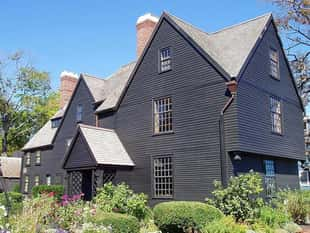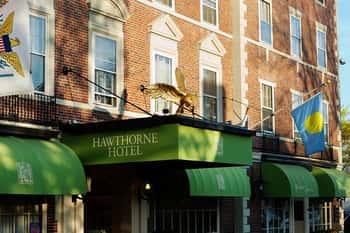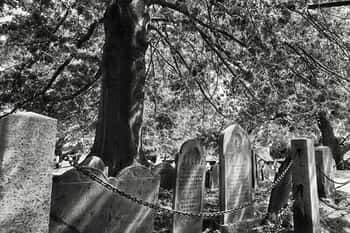Lyceum Hall, Lyceum Bar and Grill, 43 Church, Turner’s Seafood – Bridget Bishop’s apple orchard? The property of 43 Church Street is as historic as it is, well, haunted. Now a New England-style seafood and oyster bar, 43 Church Street provides nineteenth-century style in twenty-first-century Salem. Famous for more than its food, the establishment is frequented by ghosts and globetrotters alike. But how did 43 Church street, now Turner’s Seafood, inherit its reputation for the paranormal?
The property was purchased by J. Turner Seafood in 2013, but once belonged to Bridget Bishop. Yet Bishop was known for more than her apple orchards. Convicted of witchcraft in seventeenth-century Salem, Bishop was unjustly executed. She was the first of nineteen. Could Bridget Bishop’s ghost still gather apples?
In 1831, 43 Church Street was home to The Lyceum – a lecture hall for the Salem Lyceum Society. The Guest Lecturers? John Quincy Adams, Fredrick Douglas, Daniel Webster, Henry David Thoreau, Fanny Kemble, and Ralph Waldo Emerson, to name a few. Alexander Graham Bell even conducted the first demonstration of the telephone at Salem Lyceum!
Burnt to the ground, rebuilt in brick – 43 Church Street has been remade, refashioned, and renewed. What history haunts this significant site?
Blamed for black magic, Bridget Bishop was Salem’s first “convicted witch.” Bishop was hanged at Proctor’s Ledge on July 10, 1692, though more for her reputation than for her reputed witchcraft.
Indeed, the “proof” against her was unsubstantiated – “spectral evidence” or slander. Bridget had been an easy target for the conviction: thrice-married, Bishop rejected “woman’s role” in seventeenth-century Salem society. She wore what she wanted, did what she wished. The penalty? Death by hanging. Her official charges? Bewitching pigs, possessing poppets, and sending her spirit to assault Salemites.
Yet before Bridget’s unjust execution, she inherited what is now 43 Church Street from her second husband, Thomas Oliver. The property was Bishop’s apple orchard, which explains why visitors can still smell a slight scent of fruit...
Scholars once thought that Bridget Bishop’s property was located at Salem’s Washington Square. Charles Wentworth Upham, however, was able to prove that Bishop had lived at 43 Church Street.
In “Salem Witchcraft” (1867), Upham specifically references the Lyceum:
“The ‘Ship Tavern’ was on the ground the front of which is occupied, at present, by ‘West’s Block,’ nearly opposite of the head of Central Street. It had long been owned and kept by John Gedney, Sr…. John died in 1685. His widow moved into the family of her father-in-law; and, after his death in 1688, continued to keep house…The tavern, in 1692, was known as ‘Widow Gedney’s.’ The estate had an extensive orchard in the rear, contiguous, along its northern boundary, to the orchard of Bridget Bishop, which occupied ground now covered by the Lyceum building, and one or two others to the east of it.”
This haunted location provides more than the paranormal! But what, exactly, was the Lyceum?
In 1831, Salem Lyceum Society purchased the property at 43 Church Street. Lyceum Hall was soon established, providing "mutual education and rational entertainment” to Salem, Massachusetts. Lectures were held for the general public, though women were to be “introduced” by a male chaperone before they were admitted entrance.
Significant speeches include John Quincy Adams’ "Faith and Government,” and Frederic Douglas’ on "Assassination [of Abraham Lincoln] and Its Lessons.” Ralph Waldo Emerson spoke at Lyceum Hall a minimum of thirty times; indeed, Emerson’s essays were once Lyceum lectures! And, although Nathaniel Hawthorne never spoke at Lyceum Hall, Hawthorne was Lyceum’s corresponding secretary from 1848 to 1849. The Observer went so far as to say that Salem’s Lyceum was “the theatre of New England.”
“Brainchild” of Joshua Holbrook, Salem’s Lyceum had been inspired by the Mechanics Institute of England. Holbrook started the first Lyceum in Milbury, Massachusetts three years before.
Historian Jim Allister professes that “it is unlikely that any American movement has permeated the national culture as quickly and thoroughly as the lyceums in the mid-nineteenth century.” The Lyceums soon became cultural cornerstones, and, by 1834, had grown to 3,000.
Although Salem’s Lyceum would eventually stage speakers such as Clara Barton, founder of the American Red Cross, and suffragist Mary A. Livermore, women lecturers were semioccasional. Those who appeared first were musicians or performers: Mrs. Henry Lemon performed a concert in the Lyceum in 1845, and Fanny Kemble, a British actress, appeared during the 1849-50 lecture series for a reading of Shakespeare’s "A Midsummer Night's Dream.” The first female lecturer, Sara J. Lippincott, wasn’t introduced until the 1859-60 series, speaking on "The Heroic in Common Life.”
Yet The Historical Sketches of the Salem Lyceum maintained that, by 1879, “ladies have not only attended the lectures upon equal terms with gentlemen, but have assisted to deliver them, until it has come to be thought that a course is incomplete without a lady lecturer or reader.” And, in fact, the Salem’s Lyceum did host the Woman Suffrage Club of Salem.
But Salem’s Lyceum had once withheld tickets from women unless they were “introduced by a gentleman” – bold to now boast of their progressivism. (It’s no wonder Bridget Bishop haunts the Hall.)
Lyceum Hall likewise housed the Salem Female Anti-Slavery Society, an abolitionist organization that supported The Liberator publication. The Salem Female Anti-Slavery Society was notably the first of its kind, founded by and for African American women. Charlotte Forten, anti-slavery activist and poet, and Sarah Parker Remond, lecturer and abolitionist, were two members of the Salem Female Anti-Slavery Society. Alongside abolition, they advocated for anti-colonization and desegregation.
Frederic Douglass delivered a speech at Salem’s Lyceum in 1865 on the assassination of Abraham Lincoln, and abolitionist activists, such as William Lloyd Garrison and Charles Lenox Remond also made appearances.
Lyceum Hall’s most famous affair? Alexander Graham Bell’s 1877 test of the telephone. It was Bell’s first public demonstration of the device. Bell had called his assistant, Thomas A. Watson, at the Boston Globe. The event, however, was sponsored by the Essex Institute rather than the Salem Lyceum Society.
“Phantom” circuits, anyone?
By the twentieth century, the Salem Boy’s Fraternity set Salem’s Lyceum on fire. The Lyceum burned to the ground but was reconstructed as a two-story brick building.
In 1935, the Lyceum reopened as the Colonial Cafe. By 1973, it was the Lyceum Restaurant and Pub. In 1989, the Lyceum Bar & Grill. Once a cultural landmark, the Lyceum came to provide sustenance of another shade...
Today Turner’s Seafood occupies the historic site.
Doors close and open on their own; lights flicker on and off.
Boxes were once thrown down the stairs from an unseen specter. The witnesses had been hired to repair the sprinkler system, but witnessed more than they had wanted...
Employees of Salem’s Lyceum even say that they smell more than seafood… Like the slight scent of Bridget Bishop’s apple orchard. Others say that you can see Bridget Bishop herself.
Floating up the staircase and through the second story, Bridget Bishop, once the woman in red, is now the woman in white. Terri Colbert, a former employee of the property’s earlier establishment, informed the History Channel that she had spotted Bridget Bishop:
“It was a busy night. When I came up the stairs and looked up, I saw another woman standing on the other staircase leading up to the loft. I was petrified. My initial thought was that it was a person breaking into the restaurant. When I realized she wasn’t a regular person, I ran back downstairs and almost fainted.”
The woman, Colbert said, was in a seventeenth-century white dress. Colbert added that if it is Bridget Bishop, “she wouldn’t like the idea that people thought she was a witch.” Bishop is, Colbert says, “still around...professing her innocence.”
Travel Channel's Ghost Adventures likewise felt the residual energies of a woman convicted of witchcraft. Syfy’s Ghost Hunters even examined the site in 2007, though focused on spirit sightings in Lyceum’s mirrors.
The Atlantic Paranormal Society (TAPS) made the most startling discovery once they attempted to speak to Lyceum’s spirits. They heard, instead, from an antiquated cash register. The cash register printed a receipt timestamped “Good Morning,” yet the register hadn’t been programmed to print the phrase. The manager was unable to provide an explanation… Was this the ghost of Bell or Bishop?
A Wiccan group also attempted to conduct a circle at 43 Church Street. Their intentions? commune with Greek goddess Hecate. They even attempted to speak to Bridget Bishop, but she was a no-show.
They instead summoned the spirit of a young girl named Annabelle… Whose image you can find at Haven Corner on Essex Street.
Although the property once belonged to Bridget Bishop, 43 Church Street is known for more than Salem’s Witch Trials. It’s nineteenth-century history as a Lyceum Hall is likewise noteworthy. From the sixth president of the United States to the Salem Female Anti-Slavery Society, Lyceum Hall has provided lectures on politics, abolition, literature, and government. Alexander Graham Bell’s demonstration of the telephone also makes it an essential tour stop! Stop by for a spell?
Open seven days a week, Turner’s Seafood satiates the hungry and haunted alike. You can also pay homage to Bridget Bishop at Proctor’s Ledge, the site of her unjust execution. Want more? Check out our article on Bishop before stopping by!

One of Salem's most famous haunted houses

Spend a night in Salem's most haunted hotel

One of Salem's haunted Cemeteries